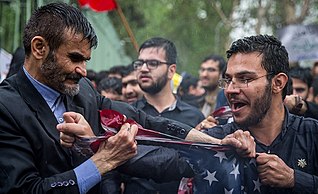United States v. Eichman, 496 U.S. 310 (1990), is a United States Supreme Court case that invalidated a federal law against flag desecration as violating of free speech under the First Amendment. It was argued together with the case United States v. Haggerty. It built on the opinion handed down in the Court's decision the prior year in Texas v. Johnson (1989), which invalidated on First Amendment grounds a Texas state statute banning flag burning.

The Workers Party of New Zealand was a socialist political party in New Zealand. It published a monthly magazine called "The Spark". In February 2013 the party was transformed from a "mass workers party" to a "fighting propaganda group". The organisation was renamed to Fightback.
The Flag Desecration Amendment is an American proposed law, in the form of constitutional amendment, that would allow the U.S. Congress to prohibit by statute and provide punishment for the physical "desecration" of the flag of the United States. The concept of flag desecration continues to provoke a heated debate over protecting a national symbol, preserving free speech, and upholding the liberty said to be represented by that national symbol.

Flag desecration is the desecration of a flag, violation of flag protocol, or various acts that intentionally destroy, damage, or mutilate a flag in public. In the case of a national flag, such action is often intended to make a political point against a country or its policies. Some countries have laws forbidding methods of destruction or forbidding particular uses ; such laws may distinguish between desecration of the country's own national flag and flags of other countries.
Texas v. Johnson, 491 U.S. 397 (1989), was a landmark decision of the US Supreme Court that invalidated prohibitions on desecrating the American flag, which at the time were enforced in 48 of the 50 states. Justice William Brennan wrote for a five-justice majority in holding that defendant Gregory Lee Johnson's act of flag burning was protected speech under the First Amendment to the United States Constitution. Johnson was represented by attorneys David D. Cole and William Kunstler.

In the United States, freedom of speech and expression is strongly protected from government restrictions by the First Amendment to the United States Constitution, many state constitutions, and state and federal laws. Freedom of speech, also called free speech, means the free and public expression of opinions without censorship, interference and restraint by the government. The term "freedom of speech" embedded in the First Amendment encompasses the decision what to say as well as what not to say. The Supreme Court of the United States has recognized several categories of speech that are given lesser or no protection by the First Amendment and has recognized that governments may enact reasonable time, place, or manner restrictions on speech. The First Amendment's constitutional right of free speech, which is applicable to state and local governments under the incorporation doctrine, only prevents government restrictions on speech, not restrictions imposed by private individuals or businesses unless they are acting on behalf of the government. However, laws may restrict the ability of private businesses and individuals from restricting the speech of others, such as employment laws that restrict employers' ability to prevent employees from disclosing their salary with coworkers or attempting to organize a labor union.
Symbolic speech is a legal term in United States law used to describe actions that purposefully and discernibly convey a particular message or statement to those viewing it. Symbolic speech is recognized as being protected under the First Amendment as a form of speech, but this is not expressly written as such in the document. One possible explanation as to why the Framers did not address this issue in the Bill of Rights is because the primary forms for both political debate and protest in their time were verbal expression and published word, and they may have been unaware of the possibility of future people using non-verbal expression. Symbolic speech is distinguished from pure speech, which is the communication of ideas through spoken or written words or through conduct limited in form to that necessary to convey the idea.

The coat of arms of New Zealand is the heraldic symbol representing the South Pacific island country of New Zealand. Its design reflects New Zealand's history as a bicultural nation, with a European female figure on one side and a Māori rangatira (chief) on the other. The symbols on the central shield represent New Zealand's trade, agriculture and industry, and a Crown represents New Zealand's status as a constitutional monarchy.
United States v. O'Brien, 391 U.S. 367 (1968), was a landmark decision of the US Supreme Court ruling that a criminal prohibition against burning a draft card did not violate the First Amendment's guarantee of free speech. Though the Court recognized that O'Brien's conduct was expressive as a protest against the Vietnam War, it considered the law justified by a significant government interest unrelated to the suppression of speech and was tailored towards that end.

The Court of Appeal of New Zealand is the principal intermediate appellate court of New Zealand. It is also the final appellate court for a number of matters. In practice, most appeals are resolved at this intermediate appellate level, rather than in the Supreme Court. The Court of Appeal has existed as a separate court since 1862 but, until 1957, it was composed of judges of the High Court sitting periodically in panels. In 1957 the Court of Appeal was reconstituted as a permanent court separate from the High Court. It is located in Wellington.
Stromberg v. California, 283 U.S. 359 (1931), was a landmark decision of the US Supreme Court ruling 7–2 that a 1919 California statute banning red flags was unconstitutional because it violated the First and Fourteenth Amendments to the United States Constitution. This decision is considered a landmark in the history of First Amendment constitutional law, as it was one of the first cases where the Court extended the Fourteenth Amendment to include a protection of the substance of the First Amendment, in this case symbolic speech or "expressive conduct", from state infringement.

The New Zealand Bill of Rights Act 1990 is a statute of the Parliament of New Zealand setting out the rights and fundamental freedoms of anyone subject to New Zealand law as a Bill of rights. It is part of New Zealand's uncodified constitution.
The following is a timeline of the flag of the United States.
The Māori protest movement is a broad indigenous-rights movement in New Zealand. While there were a range of conflicts between Māori and Europeans prior to the signing of the Treaty of Waitangi in 1840, the signing provided a legal context for protesting, as the Treaty of Waitangi made New Zealand a British colony with British law and governance applying. The British authorities had drafted the Treaty with the intention of establishing a British Governor of New Zealand, recognising Māori ownership of their lands, forests and other possessions, and giving Māori the rights of British subjects. However, the Māori and English texts of the Treaty differ in meaning significantly; particularly in relation to the meaning of having and ceding sovereignty. These discrepancies, and the British goal of colonisation, led to disagreements in the decades following the signing, including full-out warfare.
Street v. New York, 394 U.S. 576 (1969), was a United States Supreme Court case in which the Court held that a New York state law making it a crime "publicly [to] mutilate, deface, defile, or defy, trample upon, or cast contempt upon either by words or act [any flag of the United States]" was, in part, unconstitutional because it prohibited speech against the flag. The Court left for a later day the question of whether it is constitutional or unconstitutional to prohibit, without reference to the utterance of words, the burning of the flag.

Human rights in New Zealand are addressed in the various documents which make up the constitution. Specifically, the two main laws which protect human rights are the New Zealand Human Rights Act 1993 and the New Zealand Bill of Rights Act 1990. In addition, New Zealand has also ratified numerous international United Nations treaties. The 2009 Human Rights Report by the United States Department of State noted that the government generally respected the rights of individuals, but voiced concerns regarding the social status of the indigenous population.
New Zealand is committed to the Universal Declaration of Human Rights and has ratified the International Covenant on Civil and Political Rights, both of which contain a right to privacy. Despite this, currently there is no general right to privacy in New Zealand law. Privacy tends to hold the status of a value or an interest, rather than a right. Privacy interests are protected by legislation in many specific areas, and in recent years a general tort of invasion of privacy has developed. Support for the recognition of privacy as a right has been given by two Supreme Court judges, and in August 2011 the New Zealand Law Commission released the final stage of its Review of the Law of Privacy, throughout which it makes many recommendations of changes to privacy law in New Zealand.
In New Zealand, the presumption of supply is a rebuttable presumption in criminal law which is governed by the New Zealand Misuse of Drugs Act 1975. It provides an assumption in drug-possession cases that if a person is found with more than a specified amount of a controlled drug, they are in possession of it for the purpose of supply or sale. This shifts the burden of proof from the Crown to the person found with the drug, who must prove that they possessed it for personal use and not for supply. Note that once the burden of proof has shifted, the burden is one on the balance of probabilities. This presumption exists to make prosecution for supplying drugs easier.
Antony "Tony" Shaw is a barrister of the High Court of New Zealand, and a former lecturer of Law at Victoria University. He holds an LLB & BA from Auckland University, and practices as a Barrister of the High Court of New Zealand; his practice covers civil and criminal matters. He is regarded as an expert on Human Rights Law. Shaw has appeared widely in the District and High Courts of New Zealand including successful appeals to the Court of Appeal, Privy Council and the New Zealand Supreme Court. Shaw has also appeared in the Employment Court of New Zealand and regularly appears before the New Zealand Parole Board.

Brooker v Police was a case in the Supreme Court of New Zealand that concerned the meaning of "behaves in [a] disorderly manner" under section 4(1)(a) of the Summary Offences Act 1981 in light of s 14 of the New Zealand Bill of Rights Act 1990 which protects freedom of expression. The majority of the Supreme Court overturned the previous test for disorderly behaviour "which found the offence proven where behaviour was so annoying that "right-thinking members of the public" could not be expected to tolerate it"; and set aside Allistair Brooker's conviction for disorderly behaviour. Justices McGrath and Thomas in the minority argued that the right to freedom of expression should be balanced against a citizen's right to privacy in their own home.





